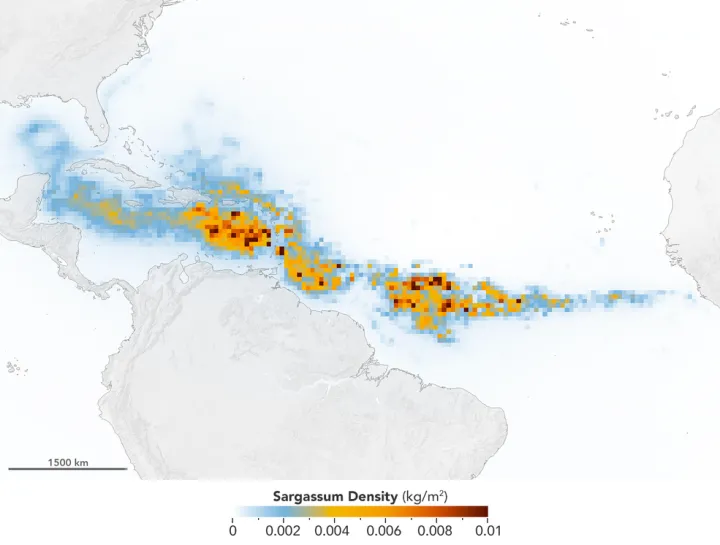Too Much of a Good Thing—the Atlantic Sargassum Belt

There is a sea in the middle of the Atlantic Ocean where floating rafts of seaweed form an oasis for ocean life. Due east of Florida and Georgia, the Sargasso Sea is a unique place—it is the only sea in the middle of the ocean. Bound by circling ocean currents that corral floating Sargassum seaweed, the Sargasso Sea has a sea surface with a flourishing ecosystem. Baby sea turtles rest and hide among the seaweed fronds, eels use the cover to spawn their young, and crabs, shrimp, and fish call it home.
But now a new hotspot of Sargassum growth is emerging, and instead of creating an oasis for ocean life the growth is causing a nuisance. Every year since 2011 (except 2013) the great Atlantic Sargassum belt has formed. Spanning from Brazil to West Africa, the belt is thousands of miles south of the Sargasso Sea where Sargassum rafts typically form. Without a strong circling current, like the one that contains the seaweed in the Sargasso Sea, at the end of the summer the seaweed has been washing up on Caribbean and Gulf of Mexico shores, smothering seagrass beds, entangling large sea creatures, and fouling beaches with desiccated seaweed and an accompanying odorous stench. Normally, sargassum is a considered a nursery habitat for juvenile sea turtles and fishery species like gray triggerfish, amberjack, and Mahi when it is in the open waters. Now it is a nuisance.
Why the sudden increase of Sargassum? Scientists suspect it is a combination of changing ocean currents due to climate change and an increase in nutrient input from Amazon deforestation that is causing the perplexing explosion of growth.
In 2009, severe flooding of the Amazon River deposited the highest amount of nutrients into the ocean in 30 years. Studies found an elevated amount of chlorophyll and high levels of dissolved oxygen in the ocean water at the mouth of the river—both indicators of high nutrients. But Sargassum need more than just nutrients. They also like a certain temperature and the ocean in 2009 was slightly warmer than they like. Then the Amazon flooded again in 2010. This time the ocean conditions were ripe for Sargassum growth and the following spring and summer, in 2011, the Sargassum grew.
Satellite imagery shows the annual Sargassum growth stretches from the western coast of Africa near Sierra Leone all the way to Mexico. In 2018, the largest bloom, over 20 million tons of Sargassum, filled the ocean. That’s the same weight as 260 space shuttles. Based upon studies that looked at ocean currents, it is unlikely that these Sargassum escaped from the Sargasso Sea. Sargassum also exists in the central Atlantic, just in sparse quantities. It is constantly moved by surface level currents around the open ocean. It is more likely that the proliferation came from here. When currents move the sargassum into the nutrient rich ocean off the coast of Brazil the sparse seaweed quickly grows into thick rafts. Then the ocean currents carries the rafts around Brazil and up into the Caribbean. The sargassum can also get caught in the main ocean current in the Gulf of Mexico, the Loop Current, which can then disperse the rafts to the shores of Mexico, Texas, and if they stay trapped in the current long enough, to Florida.
Is this the new norm? According to scientists, due to changes happening to the climate the Sargassum blooms are likely to stay. The Amazon River is a powerful force that effects the ocean and it is changing due to human activity. At the turn of the century extreme flooding of the Amazon River occurred every 20 years—now it happens on average every four. From 2009 to 2015 severe flooding happened every single year. Additionally, deforestation is adding to excess nutrients flowing into the ocean. When forests are chopped down and burned the nutrients and the soil are flushed into the ocean. The farms that take the place of the forests add nutrients as fertilizer runoff.
The heartening part of this story is that nutrient pollution is an issue that can be fixed. Community efforts in Tampa Bay reduced nitrogen pollution by 90 percent in just three years, an effort that eventually returned the decimated seagrass beds back to its historic 1950 coverage. Excess nutrients in the Danube River basin caused the appearance of a massive dead zone (a large, oxygen deprived area in an ocean or sea) in the Black Sea in the 1990s, but an international response has now decreased nitrogen levels by 20 percent and phosphorous by 50 percent. It’s a change that effectively made the dead zone disappear. One of the simplest changes was educating farmers about how to properly manage their livestock manure.
Though it may seem like a daunting task, change is possible. Perhaps, with a bit of will, the Atlantic Sargassum Belt will one day be a phenomenon of the past.



